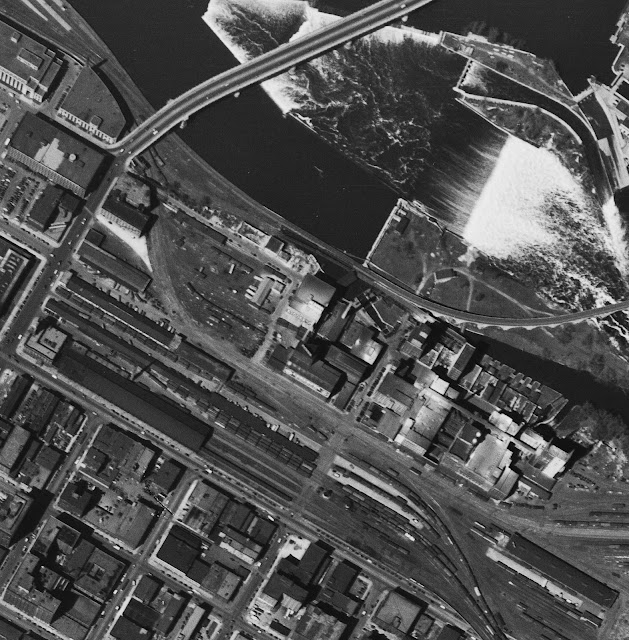 |
| Steven Carlyle Moore posted View of the West Side Milling District of Minneapolis from the courthouse showing the extensive rail yards required for the shipping of grain and flour, ca. 1912. mnhs Tom Lyman shared GN Stone Arch Bridge ever the buildings. The smoke stack with the black smoke was the Twin Cities Street Car Power Plant. [I had some trouble finding the Stone Arch Bridge. It is a little to the left of the base of the smokestacks.] |
 |
| Historic Minneapolis posted Minneapolis Milling District (1915) David Berg: The smoke rising from the smokestacks is primarily coal smoke. This would indicate that the river was low, as it usually was during the winter months. Not enough water to run the turbines at their necessary speed so every mill had a back up steam engine in an attached engine house. Running a steam engine doubled the power cost for making flour but at least the mill was running and making money. The white plume on the right is a steam locomotive crossing the Stone Arch Bridge. It would be a combination of steam and coal smoke from the locomotive boiler. With it being winter and cold air the exhaust steam would be particularly pronounced in the photo. |
 |
| Dennis DeBruler commented on Tom's share 1952 Minneapolis South Quad @ 24,000 |
 |
| Dennis DeBruler commented on Tom's share 1947 aerial photo [In the upper-left corner is part of the Union Station.] |
Look at the hydraulic jump in the upper-left corner of this image. The reason why the milling industry started here was because of the waterpower provided by the St. Anthony Falls. The town already had a lot of sawmills.
 |
| mnhs.org/millcity |
 |
| MillCity_learn "Mill City Museum was built within the ruins of the Washburn A Mill, the flagship mill of the Washburn-Crosby Co. (later General Mills). It was the largest and most technologically advanced flour mill in the world when it was completed in 1880. Millers at the Washburn mills in the 1870s perfected a new process for milling, a revolution that made fine wheat flour available to the masses for the first time. Soon thereafter Minneapolis became the flour milling capital of the world, a title it held from 1880 to 1930." |
 |
| MillCity_building, Source: MNHS Collections. Washburn A Mill Complex at its peak. "Rail lines [e.g. M&StL] delivered grain from the vast western plains to the mill. St. Anthony Falls, which had long powered the sawmills of the lumber industry, began driving turbines for the flour mills, too. Trains traveling north to Duluth's port and east to the nation's major population centers carried the milled flour to market. An influx of immigrants provided the labor. It was a recipe for success" |
 |
| Mill City History updated 1970 - Stone Arch Bridge. First off, these kids are being kind of naughty - this was an active railroad bridge, strictly off-limits. Note the skyline lacks tall buildings, the IDS Center won't be built for another 2 years. The Northwestern Bell Telephone Building (now Century Link Building) at 26 stories can be seen to the right of the City Hall Clock Tower. The Washburn A-Mill, to the right of the white silos, won't burn down for another 21 years. It's now home to the Mill City Museum. |
 |
| MillCity_history |
"At the industry's peak, more than 20 stone flour mills stood along a covered canal, flowing with water drawn from the river above the falls. When the Washburn A Mill reopened in 1880, two years after the catastrophic explosion, it was the most technologically advanced and the largest in the world. At peak production, it ground enough flour to make 12 million loaves of bread in a day. This level of production was unheard of, as most mills at the time were still smaller operations serving the towns and cities in which they were located....The flour milling complex spawned a host of innovations in manufacturing and processing. The leaders of the Minneapolis milling industry, including the Washburn, Crosby, and Pillsbury families, invented equipment and techniques that both improved the quality of flour and increased production efficiencies. White flour, something once seen as a luxury for the rich, was brought to the masses. New flour-based products, such as cake mixes, created an entirely new market for flour....In 1930, Buffalo, New York, supplanted Minneapolis as the nation's flour-milling capital, producing 11 million barrels to Minneapolis's 10.8 million annually." [MillCity_milling]
No comments:
Post a Comment